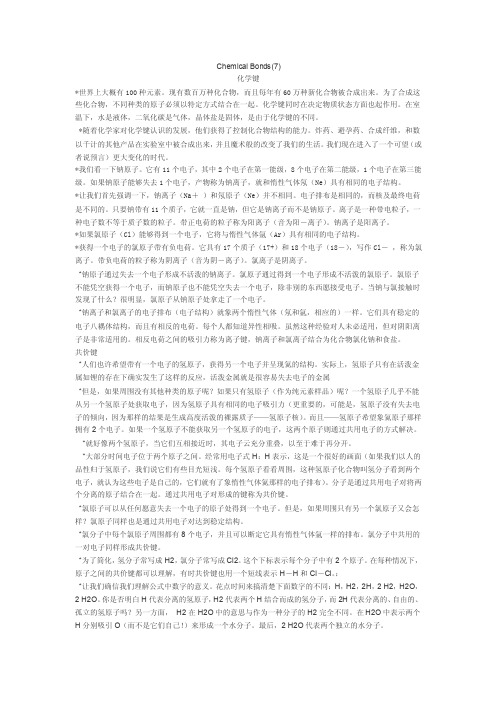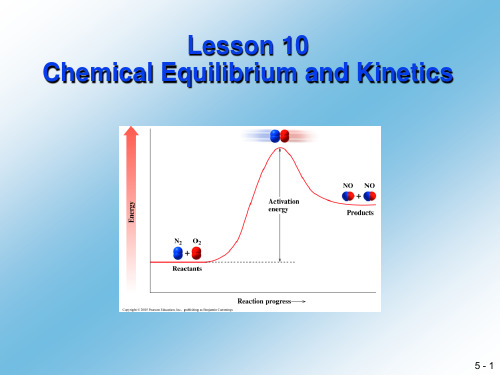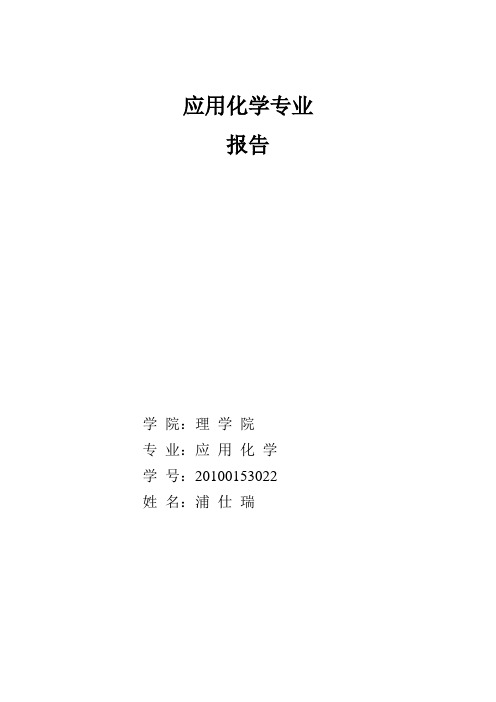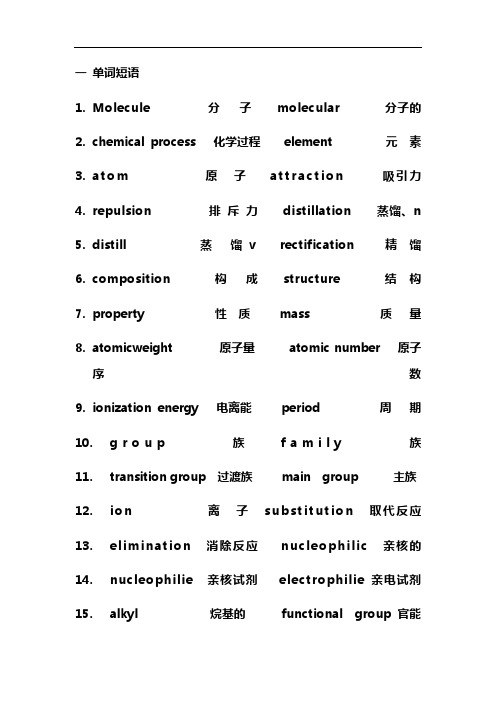东华大学应用化学专业英语总结
应用化学专业英语ChemicalBonds(7)

Chemical Bonds(7)化学键*世界上大概有100种元素。
现有数百万种化合物,而且每年有60万种新化合物被合成出来。
为了合成这些化合物,不同种类的原子必须以特定方式结合在一起。
化学键同时在决定物质状态方面也起作用。
在室温下,水是液体,二氧化碳是气体,晶体盐是固体,是由于化学键的不同。
*随着化学家对化学键认识的发展,他们获得了控制化合物结构的能力。
炸药、避孕药、合成纤维,和数以千计的其他产品在实验室中被合成出来,并且魔术般的改变了我们的生活。
我们现在进入了一个可望(或者说预言)更大变化的时代。
*我们看一下钠原子。
它有11个电子,其中2个电子在第一能级,8个电子在第二能级,1个电子在第三能级。
如果钠原子能够失去1个电子,产物称为钠离子,就和惰性气体氖(Ne)具有相同的电子结构。
*让我们首先强调一下,钠离子(Na+)和氖原子(Ne)并不相同。
电子排布是相同的,而核及最终电荷是不同的。
只要钠带有11个质子,它就一直是钠,但它是钠离子而不是钠原子。
离子是一种带电粒子,一种电子数不等于质子数的粒子。
带正电荷的粒子称为阳离子(音为阳-离子)。
钠离子是阳离子。
*如果氯原子(Cl)能够得到一个电子,它将与惰性气体氩(Ar)具有相同的电子结构。
*获得一个电子的氯原子带有负电荷。
它具有17个质子(17+)和18个电子(18-),写作Cl-,称为氯离子。
带负电荷的粒子称为阴离子(音为阴-离子)。
氯离子是阴离子。
*钠原子通过失去一个电子形成不活泼的钠离子。
氯原子通过得到一个电子形成不活泼的氯原子。
氯原子不能凭空获得一个电子,而钠原子也不能凭空失去一个电子,除非别的东西愿接受电子。
当钠与氯接触时发现了什么?很明显,氯原子从钠原子处拿走了一个电子。
*钠离子和氯离子的电子排布(电子结构)就象两个惰性气体(氖和氩,相应的)一样。
它们具有稳定的电子八耦体结构,而且有相反的电荷。
每个人都知道异性相吸。
虽然这种经验对人未必适用,但对阴阳离子是非常适用的。
浅谈应用化学专业英语

浅谈《应用化学专业英语》师胜文09231130化学化工学院09(1)班摘要:《应用化学专业英语》是各高校化学类专业的一门重要必修课程,现代社会的新形势对专业技术人才的英语水平提出了新的要求,因此我们对这门课的认识、学习方法以及实践应用都要有新的觉悟、有新的提高。
关键词:应用化学专业英语学习兴趣如何学好Discussion of specialized English of Applied ChemistryShi Shengwen 09231130College of chemistry and chemical engineering,09(1)classAbstract:"specialized English of Applied Chemistry"in chemistry specialty is an important compulsory course,modern society in the new situation for the professional and technical personnel of the English level raised new requirement,so we the class cognition, method of learning and practice to have a new understanding,new improvement.。
Key words: Applied Chemistry Specialty English interest in learning how to learn《应用化学专业英语》主要包括了应用化学专业基础英语,化学反应与化学计算,化学实验室,特殊考试考题阅读,化学专业英语口语,化学论文写作简介,科技英语简介,化学英文文献检索及网上资源简介,5个附录;其中第一部分又从无机化学、有机化学、物理化学、分析化学、生物化学、食品化学、农药化学、精细化学品化学、聚合物、化学反应工程等不同的分支予以介绍。
应用化学专业英语lesson10ChemicalEquilibriumandkinetics

NH3
Add more NH3?
Reaction shifts to the left [N2] and [H2] inc
5 - 35
Le Chatelier’s principle
Adding Pressure affects an equilibrium with gases
N2(g) + 3 H2(g)
N2(g) + 3 H2(g)
Keq =
[ NH3 ] 2 [ N2 ] [ H2 ] 3
2 NH3(g)
5 - 33
Le Chatelier’s principle
Stress causes shift in equilibrium Adding or removing reagent
N2(g) + 3 H2(g)
Temperature: 2. Higher Temperature:
Faster cars More collisions
More Energy More collisions
Reacting molecules move faster, providing colliding molecules w/ Eact.
At this point, equilibrium is achieved. Time
5 - 26
Figure 9.8
2SO2(g) + O2(g)
At Equilibium
2SO3(g)
SO2(g)+O2(g)
Initially
SO3(g)
Initially
5 - 27
Figure 9.9
2SO2(g) + O2(g)
应用化学专业英语介绍

应用化学专业报告学院:理学院专业:应用化学学号:*****************Applied chemistry specialityOne、applied chemistry speciality - main courses: Training target:This specialized raise has the chemical basic theory, basic knowledge in strong experimental skills, can in scientific research institutions, colleges and universities and enterprises and institutions, engaged in scientific research, teaching and management work of the senior specialized talents.Training requirements:Students of this specialty mainly study the basic knowledge of chemistry, the basic theory, basic skills and related engineering knowledge, is the basic research and applied basic research of scientific thought and scientific experiment training, has good scientific literacy, have use knowledge and experimental skills in applied research, technology development and technology management of the basic skills.Main courses:Main subject: chemicalMain course:Inorganic chemistry、, analytical chemistry (including instrument analysis), organic chemistry, physical chemistry (including structural chemistry, chemical engineering foundation and chemical mapping.The main practice teaching links include production practice, graduation thesis, general arrangement and a week of twenty.Length of schooling: four yearsawarded degree:physical or Bachelor'sSimilar professional:chemical applied chemistry chemical biology molecular science and engineering chemical engineering and technology Two、Four chemistry:(Inorganic chemistry, analytical chemistry, organic chemistry, physical chemistry)Inorganic chemistry:Inorganic chemistry relative to organic chemistry, the non carbon. However, some carbon compounds, such as carbon monoxide, carbon dioxide, carbon disulfide, carbonic acid compounds,cyanide and so on are still belongs to the category of inorganic chemistry. analytical chemistry:Analytical chemistry in chemistry basic theory and experiment technology as the foundation, and absorb the physical, biological, statistics, computer, automation and other aspects to enrich itself, so as to solve the content of science and technology proposed all sorts of analysis.The task of analytical chemistry(1) determining the material chemical composition, qualitative analysis(2) measurement of different components of content - quantitative analysis(3) characterization of physical chemical structure, form, energy state, structure analysis, the shape analysis, energy state analysis(4) representation composition, content, structure, form, energy state dynamics characteristics, dynamic analysisorganic chemistry:Organic chemistry is the study of organic compounds and a basic subject. It mainly includes the organic compound classification, structure, naming, property, preparation, chemical reaction and reaction mechanism of law. Organic chemistry is an important branch of chemistry, it is at the molecular level teaching carbon molecular structure and their mutual conversion mechanism, products and their separation, identification and application of basic science, chemistry, biology, pharmacy, medicine, agriculture, environment, materials science support discipline. Is to create new material is an important subject. physical chemistry:Physical chemistry is a physical principle and experiment technology as the foundation, study the properties and behavior of chemical system, found and the establishment of physical chemistry chemical system of the special law of discipline. With the rapid development of science and the mutual infiltration between subjects, physical chemistry and physics, inorganic chemistry, organic chemistry in the content are difficult to accurately demarcation line, so as to constantly create new branches, such as physical organic chemistry, biology, physics chemistry, chemical physics.Three、Applied chemistry specialty elective course: Organic synthesis, botany, colloid and surface chemistry, food chemistry, ecology, the university physics, management, professional English, plant chemistry, biological chemistry, polymer chemistry, and so on.Four、Professional teachers:Li yuqing、Li xianghong、Fuhui、Li huijuan、Liming、Liu shouqing、Liangkun、Chen yuhui、Leiran、and so on.Five、Applied chemistry employment direction:Applied chemistry professional graduates suitable to the petroleum chemical industry, environmental protection, commodity inspection, health and epidemic prevention, customs, medicine, fine chemical plant and other production, technical and administrative departments and the factories and mines enterprises engaged in applied research, technology development, production technology and management work; Can also to scientific research department and school engaged in scientific research and teaching work,。
应用化学专业英语复习资料

一单词短语1.Molecule 分子molecular 分子的2.chemical process 化学过程element 元素3.a t o m原子a t t r a c t i o n吸引力4.repulsion 排斥力distillation 蒸馏、n5.distill 蒸馏v rectification 精馏position 构成structure 结构7.property 性质mass 质量8.atomicweight 原子量atomic number 原子序数9.ionization energy 电离能period 周期10.g r o u p族f a m i l y族11.transition group 过渡族main group 主族12.i o n离子s u b s t i t u t i o n取代反应13.el i mi na ti on消除反应nucl eoph i l i c 亲核的14.nucleophilie 亲核试剂electrophilie亲电试剂15.alkyl 烷基的functional group 官能团16.halides 卤素的leaving group 离去基团17.transition state过渡态intermediate 中间体18.r e a c t a n t反应物p r o d u c t生成物19.concentration 浓度rate equation 速率方程20.c o n s t a n t常数e t h e r醚21.endothermic 吸热的substrate 反应底物22.mechanism 机理reagen 试剂23.alkene 烯烃exothermic 放热的24.A n i o n阴离子n i t r o g e n氮气25.Hydrocarbon 碳氢化合物carbonhydrate 碳水化合物26.Alkane 烷烃substituent 取代基27.Isomerism 同分异构现象isomer 同分异构28.V i n y l乙烯基d e r i v a t i v e s衍生物29.acid halides 酰卤acid anhydrides 酸酐30.e s t e r s酯a m i d e酰胺31.ammonia NH3 Acetic anhydride乙酸酐32.phenol 芬acid—base titration 酸碱滴定33.precipitation沉淀analyses 化学分析员34.IR 红外UV紫外MS质谱GC色相色谱HPLC高效液相色谱TLC薄层色谱X—rayX射线衍射二选词填空1、We can now easily account for many things,which were thought to be mysterious by theancients2、the acid acts on the metal and a gas is givenoff.3、you should adapt yourself to new ways oflooking at matters4、electrolytes have more pronounced effect oncolligative properties than do nonelectrolytes. 5、if water in these lakes evaporated at the samerate as fresh water ,both would nearly dryup in a matter of year.6、both laks evaporated very slow compared with afresh lake or even the ocean.7、a property that depends only on the relativeamounts of solute and solvent is know as acolligative property.8、for example ,both NaCl (ionic) and HCl (polarcovalent)are classified as electrolytes becausethey form ions in aqueous solution.9、when compounds such as NaCl and HCl aredissolved in water ,the effect is obvious.10、if the wires is cut ,the light goes out becausethe circuit is broken.11、when wires are attached to a charged batteryand then to a light bulb ,the light shinesbrightly.12、glass and wood as well as pure water areexamples or nonconductors of electricity.13、other substances resist the flow of electricityand are known as nonconductors orinsulators.14、it has long been known that the presence of asolute in water may affect its ability toconduct electricity.15、when the collection of papers was first broughtout,it was well received by the reviewers.16、in the same way the dozen or so mostcommon kinds of kinds of atoms can be put together in many millions of different ways tomake molecules .17、elements are made up of tiny fundamentalparticles called atoms. Fundamental, as it is usedhere ,means that they cannot be furtherdivided by any chemical metheods.18、each element has atoms that is different fromthe atoms of other elements.19、it would not be quite round; on the contraryit would consist of three parts represented byspheres.20、it is not to be summed up in a singleproduct or word ,but in an idea or basicconcept.21、the chemical symbol of an element may standthe element for.22、the rate of a chemical reaction is influencedby several factors such as temperature ,concentration of reagents , particle size ,light ,and catalyst.23、all forms of life in earth are very dependenton chemical reactions or chemical changes.24、a chemical reaction occurs when elements andcompounds react together to produce differentcompounds , or when compounds break down into simpler compounds or elements.三无机物的命名H Hydrogen Li Lithium Na Sodium K Potassium Mg Magnesium Ca CalciumMn manganese Cu copper Zn zinc Fe iron Hg mercury Ag silver Au gold C Carbon Si Silicon Pb Lead Al Aluminium F Fluorine Cl Chlorine Br Bromine I IodineO Oxygen S Sulfur N Nitrogen P Phosphorus1.直呼其名,即读其元素名称+ ion如:Na+ sodium ionK+ potassium ion2.对于有变价的金属元素,除了可用前缀来表示以外,更多采用罗马数字来表示金属的氧化态,或用后缀-ous 表示低价,-ic 表示高价如:Cu+ copper (Ⅰ) ion 或cuprous ion Cu2+ copper (Ⅱ) ion 或cupric ionFe2+ iron (Ⅱ) ion 或ferrous ionFe3+ iron (Ⅲ) ion 或ferric ion3.含氢酸根:酸根中的H读做hydrogen,氢原子的个数用希腊前缀表示:mono- di - tri- tetra - penta- hexa-hepta- octa- nona- deca-举例:CO32-carbonate ionHCO3-hydrogen carbonate ionPO43- phosphate ionHPO42hydrogencarbonate ionH2PO4- dihydrogenphosphate ion4.结晶水读做hydrate ,结晶水的个数用希腊前缀表示:mono-di - tri- tetra - penta- hexa- hepta- octa- nona- deca-CuSO4·5H2O copper(Ⅱ) sulfate pentahydrateAlCl3 ·6H2O aluminum chloride hexahydrate5.测试Mg(OH)2magnesium hydroxide AlCl3aluminum chlorideFeBr2 iron(II) bromide CaSO4calcium sulfateZnCO3zinc carbonate HF hydrofluoric acidH3PO4phosphoric acid NO2nitrogen dioxideCuO copper(II) oxide Al2O3aluminum oxideNaHSO3sodium hydrogen sulfiteKMnO4potassium permanganateNaClO sodium hypochloride四有机物的命名1)命名正烷基时,只需把烷烃的词尾“-ane换成“-yl”,加在相应的烷烃的字首后2)字母规则:Butyl>Ethyl>Isopropyl>Methyl>Neopentyl>tert-Pentyl >Propyl3)环烷烃:只需在所对应的烷烃前加上cyclo-即可4)有些结构较复杂的烷基,需添加词头5)烯烃和炔烃命名时将相应的烷烃的词尾“烷”(ane)改为“烯”(ene)或“炔”(yne),后缀前加上不饱和键的编号即可。
东华大学-应用化学-专业英语

第二课 无机化合物及化学式的命名
化学式书写的基本规则 如何写化学式 命名化合物 二元化合物:氧化物,盐,酸
(1)阴离子元素加后缀 –ide (2)多价态元素加前缀:mono-, di-, tri-, tetra-, penta-, hexa(3)低价氧化态后缀 –ou]朱红军,吕志敏.应用化学专业英语教程[M].北 京:化学工业出版社,2005. [2]万有志,王幸宜.应用化学专业英语[M].北京:化 学工业出版社,2008 (第二版). [3]丁慧,马晓燕.应用化学化工专业英语[M].哈尔 滨:哈尔滨工程大学出版社,2007. 讲 读 写 说 练 查
反应机理: reaction mechanisms 均相催化剂: homogeneous catalysis 非均相催化剂: heterogeneous catalysis 平衡常数: the equilibrium constant 反应方向: the direction of reaction 自发过程:spontaneous processes 标准熵: standard entropy 熵变: entropy changes 标准自由能变: standard free-energy changes 酸-碱: acid-bases 水离解: the dissociation of water pH值范围: the pH scales 质子转移反应: proton transfer reactions 共轭酸碱对: conjugate acid-base pairs 金属离子的水解: hydrolysis of metal ions 缓冲溶液: buffer solution 同离子效应:the common-ion effects
相关单词
化学专业英语总结

化学专业英语资料总结\基础化学常用英语词汇基础化学常用英语词汇1. The Ideal-Gas Equation 理想气体状态方程2. Partial Pressures 分压3. Real Gases: Deviation from Ideal Behavior 真实气体:对理想气体行为的偏离4. The van der Waals Equation 范德华方程5. System and Surroundings 系统与环境6. State and State Functions 状态与状态函数7. Process 过程8. Phase 相9. The First Law of Thermodynamics 热力学第一定律10. Heat and Work 热与功11. Endothermic and Exothermic Processes 吸热与发热过程12. Enthalpies of Reactions 反应热13. Hess’s Law 盖斯定律14. Enthalpies of Formation 生成焓15. Reaction Rates 反应速率16. Reaction Order 反应级数17. Rate Constants 速率常数18. Activation Energy 活化能19. The Arrhenius Equation 阿累尼乌斯方程20. Reaction Mechanisms 反应机理21. Homogeneous Catalysis 均相催化剂22. Heterogeneous Catalysis 非均相催化剂23. Enzymes 酶24. The Equilibrium Constant 平衡常数25. the Direction of Reaction 反应方向26. Le Chatelier’s Principle 列•沙特列原理27. Effects of Volume, Pressure, Temperature Changes and Catalystsi. 体积,压力,温度变化以及催化剂的影响28. Spontaneous Processes 自发过程29. Entropy (Standard Entropy) 熵(标准熵)30. The Second Law of Thermodynamics 热力学第二定律31. Entropy Changes 熵变32. Standard Free-Energy Changes 标准自由能变33. Acid-Bases 酸碱34. The Dissociation of Water 水离解35. The Proton in Water 水合质子36. The pH Scales pH值37. Bronsted-Lowry Acids and Bases Bronsted-Lowry 酸和碱38. Proton-Transfer Reactions 质子转移反应39. Conjugate Acid-Base Pairs 共轭酸碱对40. Relative Strength of Acids and Bases 酸碱的相对强度41. Lewis Acids and Bases 路易斯酸碱42. Hydrolysis of Metal Ions 金属离子的水解43. Buffer Solutions 缓冲溶液44. The Common-Ion Effects 同离子效应45. Buffer Capacity 缓冲容量46. Formation of Complex Ions 配离子的形成47. Solubility 溶解度48. The Solubility-Product Constant Ksp溶度积常数49. Precipitation and separation of Ions 离子的沉淀与分离50. Selective Precipitation of Ions 离子的选择沉淀51. Oxidation-Reduction Reactions 氧化还原反应52. Oxidation Number 氧化数53. Balancing Oxidation-Reduction Equations 氧化还原反应方程的配平54. Half-Reaction 半反应55. Galvani Cell 原电池56. Voltaic Cell 伏特电池57. Cell EMF 电池电动势58. Standard Electrode Potentials 标准电极电势59. Oxidizing and Reducing Agents 氧化剂和还原剂60. The Nernst Equation 能斯特方程61. Electrolysis 电解62. The Wave Behavior of Electrons 电子的波动性63. Bohr’s Model of The Hydrogen Atom 氢原子的波尔模型64. Line Spectra 线光谱65. Quantum Numbers 量子数66. Electron Spin 电子自旋67. Atomic Orbital 原子轨道68. The s (p, d, f) Orbital s(p,d,f)轨道69. Many-Electron Atoms 多电子原子70. Energies of Orbital 轨道能量71. The Pauli Exclusion Principle 泡林不相容原理72. Electron Configurations 电子构型73. The Periodic Table 周期表74. Row 行75. Group 族76. Isotopes, Atomic Numbers, and Mass Numbers 同位素,原子数,质量数77. Periodic Properties of the Elements 元素的周期律78. Radius of Atoms 原子半径79. Ionization Energy 电离能80. Electronegativity 电负性81. Effective Nuclear Charge 有效核电荷82. Electron Affinities 亲电性83. Metals 金属84. Nonmetals 非金属85. Valence Bond Theory 价键理论86. Covalence Bond 共价键87. Orbital Overlap 轨道重叠88. Multiple Bonds 重键89. Hybrid Orbital 杂化轨道90. The VSEPR Model 价层电子对互斥理论91. Molecular Geometries 分子空间构型92. Molecular Orbital 分子轨道93. Diatomic Molecules 双原子分子94. Bond Length 键长95. Bond Order 键级96. Bond Angles 键角97. Bond Enthalpies 键能98. Bond Polarity 键矩99. Dipole Moments 偶极矩100. Polarity Molecules 极性分子101. Polyatomic Molecules 多原子分子102. Crystal Structure 晶体结构103. Non-Crystal 非晶体104. Close Packing of Spheres 球密堆积105. Metallic Solids 金属晶体106. Metallic Bond 金属键107. Alloys 合金108. Ionic Solids 离子晶体109. Ion-Dipole Forces 离子偶极力110. Molecular Forces 分子间力111. Intermolecular Forces 分子间作用力112. Hydrogen Bonding 氢键113. Covalent-Network Solids 原子晶体114. Compounds 化合物115. The Nomenclature, Composition and Structure of Complexes 配合物的命名,组成和结构116. Charges, Coordination Numbers, and Geometries 电荷数、配位数、及几何构型117. Chelates 螯合物118. Isomerism 异构现象119. Structural Isomerism 结构异构120. Stereoisomerism 立体异构121. Magnetism 磁性122. Electron Configurations in Octahedral Complexes 八面体构型配合物的电子分布123. Tetrahedral and Square-planar Complexes 四面体和平面四边形配合物124. General Characteristics 共性125. s-Block Elements s区元素126. Alkali Metals 碱金属127. Alkaline Earth Metals 碱土金属128. Hydrides 氢化物129. Oxides 氧化物130. Peroxides and Superoxides过氧化物和超氧化物131. Hydroxides 氢氧化物132. Salts 盐133. p-Block Elements p区元素134. Boron Group (Boron, Aluminium, Gallium, Indium, Thallium) 硼族(硼,铝,镓,铟,铊)135. Borane硼烷136. Carbon Group (Carbon, Silicon, Germanium, Tin, Lead) 碳族(碳,硅,锗,锡,铅)137. Graphite, Carbon Monoxide, Carbon Dioxide 石墨,一氧化碳,二氧化碳138. Carbonic Acid, Carbonates and Carbides 碳酸,碳酸盐,碳化物139. Occurrence and Preparation of Silicon 硅的存在和制备140. Silicic Acid,Silicates 硅酸,硅酸盐141. Nitrogen Group (Phosphorus, Arsenic, Antimony, and Bismuth) 氮族(磷,砷,锑,铋)142. Ammonia, Nitric Acid, Phosphoric Acid 氨,硝酸,磷酸143. Phosphorates, phosphorus Halides 磷酸盐,卤化磷144. Oxygen Group (Oxygen, Sulfur, Selenium, and Tellurium) 氧族元素(氧,硫,硒,碲)145. Ozone, Hydrogen Peroxide 臭氧,过氧化氢146. Sulfides 硫化物147. Halogens (Fluorine, Chlorine, Bromine, Iodine) 卤素(氟,氯,溴,碘)148. Halides, Chloride 卤化物,氯化物149. The Noble Gases 稀有气体150. Noble-Gas Compounds 稀有气体化合物151. d-Block elements d区元素152. Transition Metals 过渡金属153. Potassium Dichromate 重铬酸钾154. Potassium Permanganate 高锰酸钾155. Iron Copper Zinc Mercury 铁,铜,锌,汞156. f-Block Elements f区元素157. Lanthanides 镧系元素158. Radioactivity 放射性159. Nuclear Chemistry 核化学160. Nuclear Fission 核裂变161. Nuclear Fusion 核聚变162. analytical chemistry 分析化学163. qualitative analysis 定性分析164. quantitative analysis 定量分析165. chemical analysis 化学分析166. instrumental analysis 仪器分析167. titrimetry滴定分析168. gravimetric analysis 重量分析法169. regent 试剂170. chromatographic analysis 色谱分析171. product 产物172. electrochemical analysis 电化学分析173. on-line analysis 在线分析174. macro analysis 常量分析175. characteristic 表征176. micro analysis 微量分析177. deformation analysis 形态分析178. semimicro analysis 半微量分析179. systematical error 系统误差180. routine analysis 常规分析181. random error 偶然误差182. arbitration analysis 仲裁分析183. gross error 过失误差184. normal distribution 正态分布185. accuracy 准确度186. deviation偏差187. precision 精密度188. relative standard deviation 相对标准偏差(RSD)189. coefficient variation 变异系数(CV)190. confidence level 置信水平191. confidence interval 置信区间192. significant test 显著性检验193. significant figure 有效数字194. standard solution 标准溶液195. titration 滴定196. stoichiometric point 化学计量点197. end point滴定终点。
应用化学专业英语 复习总结

英译汉:1.First, electrons are added one at a time moving from left to right across a period……首先,从左向右横跨一个周期时每次增加一个电子。
当这种情况发生时,最外层电子将受到逐渐增强的核引力,所以电子将更接近原子核而受到其更紧密的束缚力。
其次,在周期表中从上向下移动一列,最外层电子受到核的束缚力将变弱。
这是因为主能级数(屏蔽最外层电子受到核的吸引)在每族向下移动时增加。
这些趋势解释了通过观察元素的原子半径、电离能、电子亲和力和电负性而得到的元素性质的周期性规律。
2.It is important to note that at equilibrium the rates of reaction,rate r and rate f are equilibriummixture are usually not equal……值得注意的是,在化学平衡时的反应速率,正反应速率和你反应速率相等但反应物和生成物的摩尔浓度在平衡混合态时一般不相等。
但是,事实上每种反应物和生成物在平衡时其浓度为定值,因为每种物质在一个反应中的消耗速率与其在相应你反应正的生成速率相等。
在化学平衡提出之前,这种系统被称为动力学平衡状态。
3.This is a mathematical expression of the law of chemical equilibrium which may be stated as follows:When a reversible…………这是化学平衡定律的数学表达式,它可以通过如下所述:当一个可逆反应在给定温度下达到平衡时,在方程式中箭头右边物质的摩尔浓度的积除以左边物质摩尔浓度的积(每种物质浓度的幂等于反应方程式中每种物质的分子数)为定值,4.Analytical chemistry,or the art of recognizing different substances and determining theirconstituents, takes a prominent position among分析化学或鉴定不同物质并测定其成分的技术,因为可以解决每当化学过程被用于科学的或技术性的目的是产生的问题,而在科学应用领域中占显著地位。
- 1、下载文档前请自行甄别文档内容的完整性,平台不提供额外的编辑、内容补充、找答案等附加服务。
- 2、"仅部分预览"的文档,不可在线预览部分如存在完整性等问题,可反馈申请退款(可完整预览的文档不适用该条件!)。
- 3、如文档侵犯您的权益,请联系客服反馈,我们会尽快为您处理(人工客服工作时间:9:00-18:30)。
专业英语重点总结单词Toxic chemicals:有毒化学品 Chemical pollution:化学污染Physical property :物性 Isolate:分离Determine:测定 Synthesize:合成Fundamental principles:基本原理 Investigation:研究Utilize:利用 Catalyst 催化剂Enzyme 酶 Biosphere 生物圈Heterogeneous catalyst 非均相催化剂 Nanotechnology 纳米技术Carbon monoxide 一氧化碳 Chemical formulas:化学式anion: 阴离子 Oxidation number:氧化值sulphate: 硫酸盐 Hydrides: 氢化物Sodium:钠 cation: 阳离子Covalent bond:共价键 electroneutral: 电中性的Electronegative atom:电负性原子 trivial names:俗名Oxidation:氧化 Peroxides:过氧化物Superoxide:超氧化物 Periodic table:周期表Noble gases: 惰性气 vacant orbital:空轨道Coordination (complex) compound: 配位化合物Unshared pair of electrons:未共用电子对oxidation state:氧化态 hydroxides:氢氧化物caustic soda solution:苛性钠溶液 vacant orbital:空轨道Formula 分子式 Common name 俗名Derivative 衍生物 Acid salt 酸式盐Hydrate 水合物 Anhydrous 无水的Oxidizing agent 氧化剂 Reducing agent 还原剂Oxidation reduction reaction氧化还原反应Electrochemistry 电化学 Electrolysis 电解Strong acid 强酸 Weak base 弱碱Acid-base indicator 酸碱指示剂 Distilled water 蒸馏水Buffer solution 缓冲溶液 Common ion effect 同离子效应Equivalence point 等效点 Neutralization 中和Dissociation 离解度 Anhydride 脱水物Periodic law: 元素周期率 periods (rows):周期group (columns):族 protons:质子Valence electrons:价电子 Halogens: 卤素Atomic radius: 原子半径 alkaline earths:碱土金属attractive force: 吸引力 electronegativity: 电负性electropositive:正电性 univalent ion: 一价离子electron shell: 电子层 bonding force 结合力monatomic 单原子的 Neutrons:中子hydrogen bond 氢键 conduct electricity 导电Electrically neutral 电中性的 Electrostatic 静电的isomerism :异构现象 Reversible :可逆的Chirality :手性 Charge:电荷mirror image:镜像 mirror image:镜像Hydrocarbons:碳氢化合物 Methane: 甲烷propane :丙烷 butane :丁烷-ane:-烷 -ene:烯-yne:炔 -ol:醇-one :酮 -al:醛-aldehyde: 醛 -acetal:缩醛alkoxy-:烷氧基 -amide: 酰胺-amino:氨基的 -amine : 胺Aquo- 含水的 azo- 偶氮Polythene (PE): 聚乙烯 Benzene:苯Ethene:乙烯 Propene:丙烯double bond:双键 triple bond:三键Valence bond theory 价键理论 skeleton:骨架methyl:甲基 ethyl:乙基alkyl :烷基 side chains: 侧链substituent:取代基Meth-:甲 eth-:乙propyl-:丙 but-:丁Pent(a)-:戊 hex-:己hepta-:庚 oct-:辛non-:壬 deca-:葵di-:二 tri- : 三tetra- : 四 penta-: 五primary carbon:伯碳 secondary carbon:仲碳tertiary carbon:叔碳 allyl :烯丙基substitution reaction :取代反应 free radical:自由基nucleophilic substitution:亲核取代 carbocation :碳正离子electrophilic substitution:亲电取代 carbanion :碳负离子addition reaction :加成反应elimination reaction:消去反应acid anhydride:酸酐 alcohol:乙醇Thermodynamics 热力学 quantum chemistry 量子化学statistical mechanics 统计力学 Kinetics 动力学Equilibrium 平衡 deposition 沉积sublimation 升华 Condensation 冷凝evaporation 蒸发 Melting 熔化Freezing 冷冻 Work 功the states of system系统状态Irreversible 不可逆的 surrounding 环境open system 开放系统 closed system 封闭系统isolated system 孤立系统 impermeable 不可渗透的Adiabatic 绝热的 steady state稳态tap water 自来水 rinse 润洗fine chemicals 精细化学品 Buchner funnel 布氏漏斗bunsen burners 煤气喷灯 tripod supports 三角支架wash bottles 洗瓶 dropper 滴管transfer pipette 移液管 hot plate 轻便电炉wire gauzes 石棉网 test tube brush 试管刷test tube rack 试管架filter paper 滤纸ring stand with rings 带环环架iron support 铁架台utility clamp 铁试管夹 clamp holder 夹柄buret clamp 滴定管夹 extension clamp 万能夹ring clamp 环形夹子 pinchcock 弹簧夹pinch clamp 弹簧节流夹 tubing clamp 管夹hose clamp 软管夹 test tube clamp 试管夹cork stopper 软木塞 rubber stopper 橡胶塞laboratory jack 实验升降台 spatulas 刮刀beaker tongs 烧杯钳 crucible tongs 坩埚钳tweezer 镊子 watch glasses 表面皿goggles 护目镜fume hoods 通风橱capillary melting point tube 毛细熔点管 Caliper 卡尺table balance 托盘天平 analytical balance 分析天平top pan balance 市秤 magnetic stirrers 电磁搅拌器Fahrenheit thermometer 华氏温度计 celsius 摄氏度magnetic stir bar 磁搅拌子 alcohol lamp 酒精灯Spectrophotometers 分光光度计 connection tube 连接管rubber tube 橡皮管 adapter 接合器Socket 套接口 ball joint 球形接头Stopper 塞子 adaptor 转接口splash heads 防溅头 thermometer pocket温度计插孔air leak tube 空气渗漏管 distill head 蒸馏头melting point tube 熔点管 burettes 滴定管Stopcock 活塞 volumetric flask 容量瓶measuring cylinder 量筒 centrifuge tube 离心管graduated pipette刻度吸量管 filter funnel 过滤漏斗chromatography colum 层析柱dropping funnel 滴液漏斗pressure equalizing funnel 均压漏斗 separating funnel 分液漏斗rotary evaporator 旋转蒸发仪 petri dishes 培养皿spectrophotometer 分光光度计 drying tube 干燥管evaporating dishes 蒸发皿 condenser 冷凝管Reflux 回流 erlenmeyer flask 锥形烧瓶round bottom flask 圆底烧瓶 distillation flask 蒸馏烧瓶filtration flask 过滤瓶 reagent bottle 试剂瓶glass desiccator 玻璃干燥器Beaker 烧杯distilling receiver 蒸馏接收器dry tower 干燥塔vaccume dessicator 真空干燥器 extractor 萃取器无机化合物及化学式的命名·二元化合物:氧化物,盐,酸(1)阴离子元素加后缀–ide(2)多价态元素加前缀:mono-, di-, tri-, tetra-, penta-, hexa(3)低价氧化态后缀–ous,高价氧化态后缀–ic·酸:基础元素(前缀 hydro-, 后缀-ic)+ acid·氢氧化物(碱):金属元素(价态)+ hydroxide·含氧酸及其盐(1)基本元素仅有一种氧化态酸:基础元素加后缀-ic + acid盐:阳离子元素+基础元素加后缀-ate(2)基本元素有二种氧化态酸:基础元素加后缀( -ous低价态,-ic高价态) + acid盐:阳离子元素 + 基础元素加后缀( -ite低价态, -ate高价态)(3)基本元素有多种氧化态酸:最低氧化态基础元素(前缀 hypo-, 后缀-ous)+ acid较低氧化态基础元素加后缀-ous+ acid较高氧化态基础元素加后缀-ic + acid最高氧化态基础元素(前缀 per-, 后缀-ic)+ acid 盐:最低氧化态阳离子元素 + 基础元素(前缀 hypo-, 后缀-ite)较低氧化态阳离子元素 + 基础元素加后缀-ite较高氧化态阳离子元素 + 基础元素加后缀-ate最高氧化态阳离子元素 + 基础元素(前缀 per-, 后缀-ate)·不同水分子含量的酸较低水含量前缀 meta较高水含量前缀 ortho·不同基本元素形成的酸前缀 di-, pyro·含硫的酸:源于含氧酸中的氧被硫取代,使用前缀 thio·含氢盐(酸式盐):源于含有1个以上氢原子酸中的氢原子被金属离子取代,形成酸式盐,氢原子以及金属离子使用前缀 di-, (bi),tri·配位化合物的命名阳离子 + [ 配体及中心原子] (氧化数)前缀:prefix·二元化合物,原子个数前缀1—mono-(可省略);2—di-;3—tri-;4—tetra-;5—penta-;6—hexa- Eg:·Oxide-氧化物CaO:calcium oxide(quicklime-生石灰)N2O:nitrogen(Ⅰ) oxide = dinitrogen oxide = nitrous oxide(laughing gas) NO:nitrogen(Ⅱ) oxide = nitrogen oxide = nitric oxideN 2O3:nitrogen(Ⅲ) oxide = dinitrogen trioxideNO2:nitrogen(Ⅳ) oxide = nitrogen dioxideN 2O5:nitrogen(Ⅴ)oxide = dinitrogen pentaoxideCu2O: copper(Ⅰ) oxide = dicopper oxide = cuprous oxide-低价态CuO: copper(Ⅱ) oxide = cupric oxide-高价态·Salt-盐ZnF2: znic fluorideSnCl2: tin(Ⅱ) chloride = stannous chlorideHg2Cl2: mercury(Ⅰ) chloride = mercurous chloride (calomel-甘汞)HgCl2: mercury(Ⅱ) chloride = mercuric chloride (sublimate) KCN: potassium cyanide·Acids-酸HBr: hydrobromic acid (aqueous solution)HCN: hydrocyanic acidH2S: hydrosulphuric acid·Hydroxides(bases)-碱NaOH: sodium hydroxide (sodium lye, caustic soda solution) KOH: potassium (hydroxid potassium lye, caustic potash)Fe(OH)2: iron(Ⅱ) hydroxide (ferrous hydroxide)Fe(OH)3: iron(Ⅲ) hydroxide (ferric hydroxide)·Oxo acids and their salts-含氧酸及其盐H2CO3: carbonic acid Na2CO3: sodium carbonateH3BO3: boric acid K3BO3: potassium borate·The basic element is in two oxidation statesHNO2: nitrous acid NaNO2: sodium nitriteHNO3: nitric acid Co(NO3)2: cobalt(Ⅱ) nitrate = cobaltous nirate·The basic element is in more than two oxidation states HClO: hypochlorous acid KClO: potassium hypochloritaHClO2: chlorous acid KClO2: potassium chloriteHClO3: chloric acid KClO3: potassium chlorateHClO4: perchloric acid KClO4: potassium perchlorateHMnO4: permanganic acid AgMnO4:sliver permanganate·The hydrogen salt-含氢盐Na3PO4: trisodium phosphate (tertiary phosphate)Na2HPO4: disodium hydrogen phosphate (secondary phosphate)NaH2PO4: sodium dihydrogen phosphate (primary phosphate)NaHCO3: sodium hydrogen carbonate (sodium bicarbonate) ·Give formulas for the following1.ammonium sulfate: (NH4)2 SO42.barium iodide: BaI23.iron(Ⅱ) sulfate:Fe2SO44.potassium permanganate:KMnO4 5.copper(Ⅱ)oxide:CuO6.carbonic acid:H2CO3科技论文写作Introduction section-研究的是什么问题?Key sections·Materials and Methods section-这个问题是怎么研究的?·Results and Discussion sections-发现了什么?Conclusion section-这些发现意味着什么?1.ABSTRACT (摘要)研究动机、研究方法、主要结果、简要结论摘要应言简意赅,因此以上各项内容争取用一句话说明一项,每项最多不要超过三句话,即:为什么做这个研究?用了什么方法?取得了什么结果?结论是什么?这些问题逐一回答了,摘要就写完整了。
